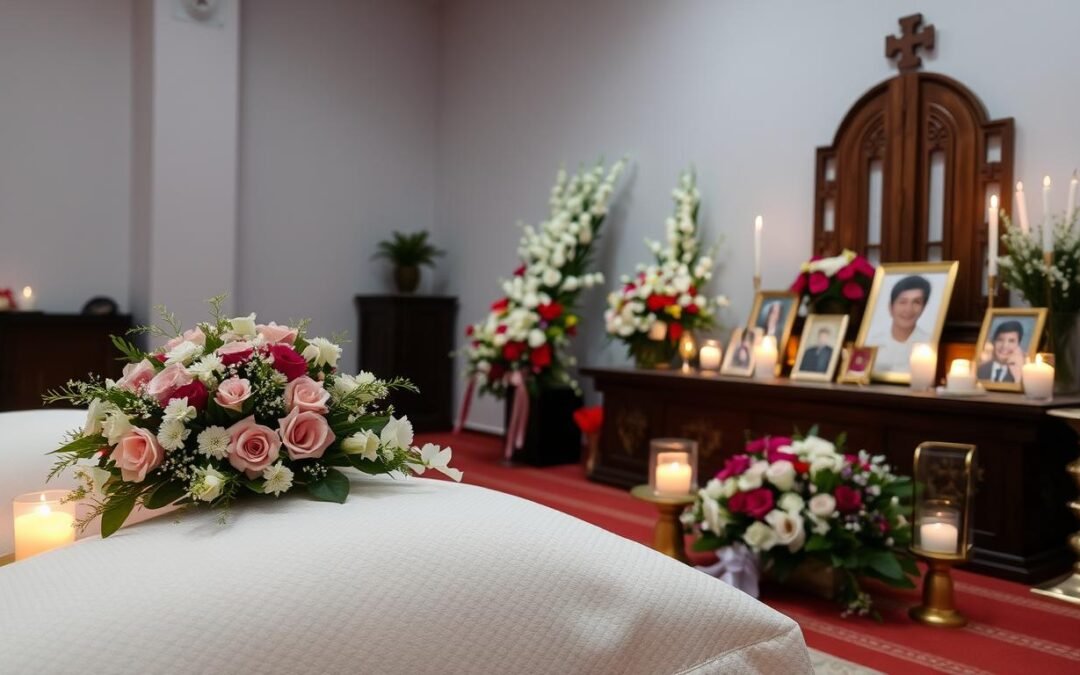In Singapore, the wake service is very important. It’s a time for friends and family to come together and support those who are grieving. Knowing the right funeral etiquette is key, given the country’s diverse cultures.
These customs mix different traditions, showing respect for the deceased and the family’s values. Being sensitive in these moments can make a big difference. It ensures that condolences are well-received, making the experience respectful and meaningful.
Understanding the Importance of Wake Services
Wake services are key in the grieving process. They let family and friends come together to honor the deceased. These gatherings are more than just a tradition; they are a space for collective mourning and remembrance.
At a wake, people can share their memories and express condolences. It’s a first step towards healing after a loss. Memorial practices vary but are vital in fostering social connections during tough times.
The importance of wake services lies in their ability to strengthen community bonds. They give everyone a chance to support one another. In a diverse society like Singapore, these services reflect cultural sensitivity.
They accommodate various traditions and beliefs. Options like themed funerals or eco-friendly choices are available. This shows the adaptability of funeral practices, including biodegradable coffins and natural burial alternatives.
Different cultures influence the ways wakes are held. Understanding these variations is key to honoring the deceased properly. Whether it’s a Taoist, Buddhist, Islamic, or Hindu wake, each tradition has unique practices that reflect Singapore’s diverse beliefs.
These gatherings do more than just help with immediate grieving. They also build a foundation for lasting relationships among those left behind.
Cultural and Religious Diversity in Funeral Practices
Singapore’s mix of cultures makes its funeral practices unique. Different religious customs are key, making wake services special. Communities like Buddhists, Taoists, Christians, and Muslims each bring their own traditions.
Buddhist wakes last for days, focusing on good karma for the deceased. This helps them in their next life or towards Nirvana. Taoist funerals have many rituals, varying by dialect group like Teochew, Hokkien, and Hakka.
Christian and Catholic wakes are about prayers, hymns, and scripture. They celebrate the life of the deceased and support the community. Muslim wakes are shorter, with Quran recitation and prayers.
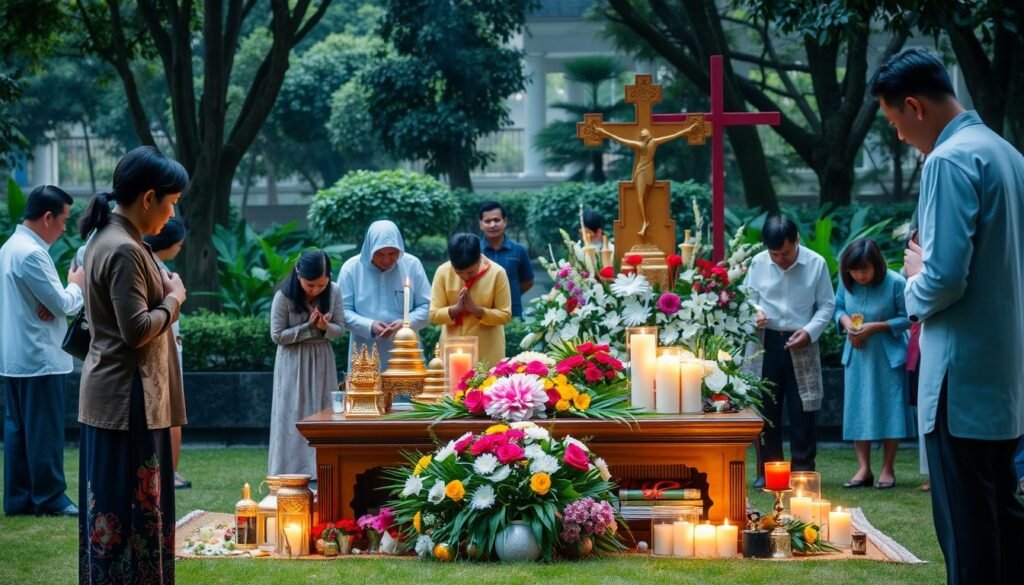
Hindu wakes include bathing and dressing the body, with flower offerings and prayers. These rituals show respect for life and the soul’s journey. Each culture honors its traditions, building community solidarity.
| Religious Group | Key Practices | Duration |
|---|---|---|
| Buddhist | Positive karma generation, chanting | Several days |
| Taoist | Rituals vary by dialect group | Several days |
| Christian | Prayers, hymns, memorial service | 1-2 days |
| Catholic | Scripture readings, rituals of the Church | 1-2 days |
| Muslim | Reading Quran, prayers | Brief |
| Hindu | Body preparation, mantra recitation | Several days |
Going to these multicultural funerals shows respect for different customs. It also helps everyone share in grief, finding comfort. Understanding these differences makes Singapore’s community stronger during hard times.
General Etiquette When Attending a Wake
Going to a wake means being sensitive and aware of the feelings around the loss. Knowing the basics of funeral etiquette helps people show their condolences right. Being thoughtful in wake service behavior makes the experience better for everyone.
Being on time is key. It shows respect for the family and their grief. Don’t stay too long, as it can add to their stress. Instead, focus on showing respect in meaningful ways, like through calm talks or joining in rituals.
Helping out during the wake is a big help. Simple acts like setting up chairs or bringing snacks can ease the family’s load. In many cultures, bringing food, like at a home wake, is a big deal. It shows you care and are there for them.
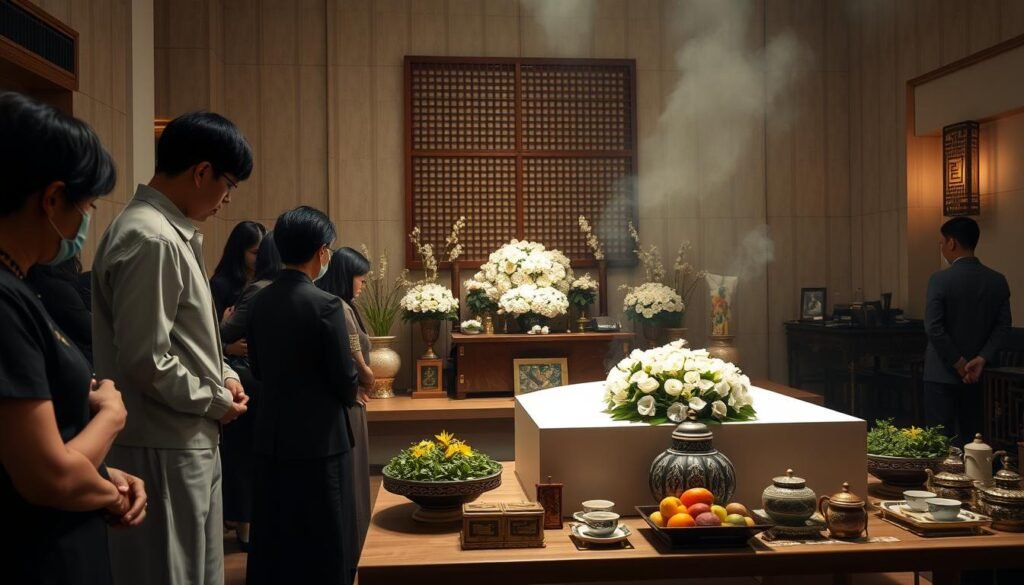
What you wear and the colors you choose matter too. Dark and muted colors are usually best, keeping the mood serious but respectful. In some places, lighting incense is a way to show respect, with a focus on one stick. Red threads on tables might also be seen as lucky during this time.
Flowers are common at funerals, but some families like them at wakes too. Others might prefer donations to charity. Paying attention to what the family wants with these gestures can make a big difference.
It’s important to know the customs of different cultures to show real respect. For example, Buddhist wakes include chanting and incense, while Hindu ones have prayers and rituals for cremation. Some Muslim traditions skip the wake, focusing on burial prep right away. Each way honors life and death in its own special way.
Wake Service Rituals: Paying Your Respects
Paying respects during wake service rituals is a key part of honoring the deceased and supporting their family. These rituals vary a lot based on cultural practices. It’s important for guests to understand the context of the services they attend.
Participating in these rituals, whether through prayer, simple observation, or personalized condolences, shows genuine sympathy. It’s a way to connect with the family and honor the deceased.
Common Practices Across Cultures
In Singapore, different cultures have unique ways of showing respect. At Buddhist and Taoist funerals, attendees stand before the altar and light joss sticks. This act is both a tribute and a moment of reflection.
Christian and Catholic wake services may include singing hymns and sharing scripture. This allows participants to connect through shared faith and support. It’s important to maintain a quiet and respectful demeanor during the ceremonies.
Personalizing Your Respect According to Beliefs
Understanding and respecting beliefs is key when personalizing condolences at a wake. Guests may ask the family discreetly about their preferences. This is important if certain rituals might conflict with personal convictions.
Offering support by simply being present or sending flower wreaths or condolence money can be heartfelt. Attendees should always strive to navigate these sensitive matters with care and consideration. This honors the deceased and their loved ones.
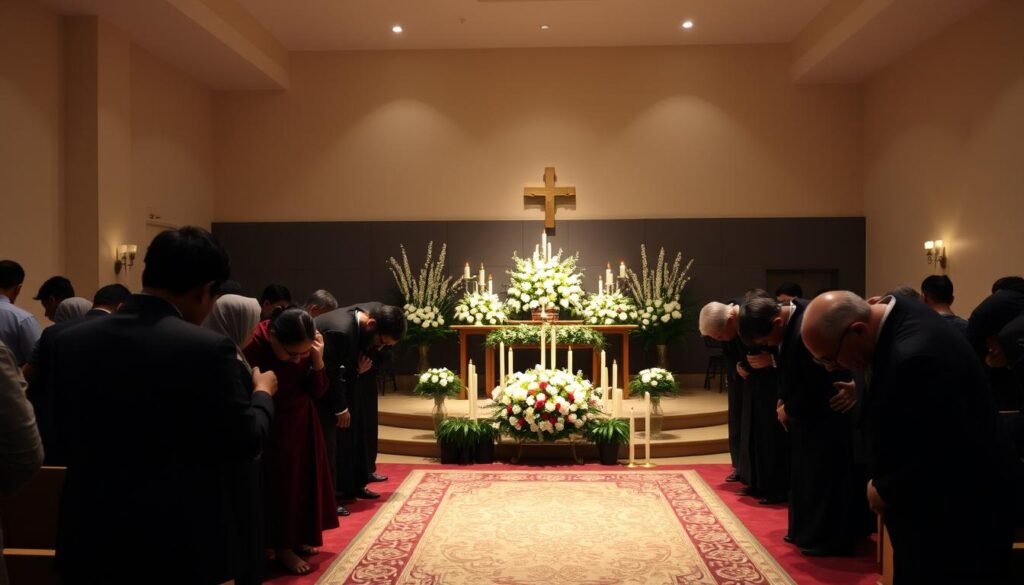
Appropriate Attire for a Wake Service
Choosing the right clothes for a wake service shows respect for the deceased and their family. The wake service dress code usually includes dark, muted colors like black, grey, dark blue, or dark red. These colors reflect the serious mood of the event.

In Western cultures, formal yet modest clothes are key. Men often wear a suit and tie or a long-sleeve shirt with dark pants and dress shoes. Women might choose formal pants, a dress or skirt, or a blouse with a blazer, all in dark colors.
It’s best to avoid bright colors, casual clothes like jeans or shorts, and sporty items like baseball caps. Simple, neutral accessories are preferred. This shows respect for the occasion and keeps the focus on honoring the deceased.
While wakes are less formal than funerals, dressing respectfully is important. It’s wise to avoid loud patterns and choose subdued clothes. Many families have both a wake and a funeral, with the wake happening before or after the funeral.
Giving Condolence Money: Understanding Pek Kim
In Singapore, giving condolence money is a special tradition. It’s known as pek kim or bai jin in the Chinese community. This act shows respect for the deceased and support for the grieving family.
How much to give depends on family ties, financial situation, and personal choice. It’s a way to honor the deceased and help the family during a tough time.
Recommended Amounts for Contributions
The amount of money given varies based on how close you were to the person who passed away. Here are some guidelines:
- Close Family: $170 to $340 SGD
- Friends: $85 to $170 SGD
- Colleagues: $35 to $85 SGD
It’s customary to give odd numbers like $30, $50, or $100. This shows respect during sad times. Giving even numbers, like those for celebrations, is not suitable.
How to Present Condolence Money Respectfully
When giving condolence money, be careful and respectful. It’s common to put it in a white envelope and give it to a family member. If envelopes are not available, giving cash directly is okay.
Technology has made it easier to give money at funerals. Digital transfers, like PayNow, are becoming more popular. But, giving money in person shows more sincerity and care.
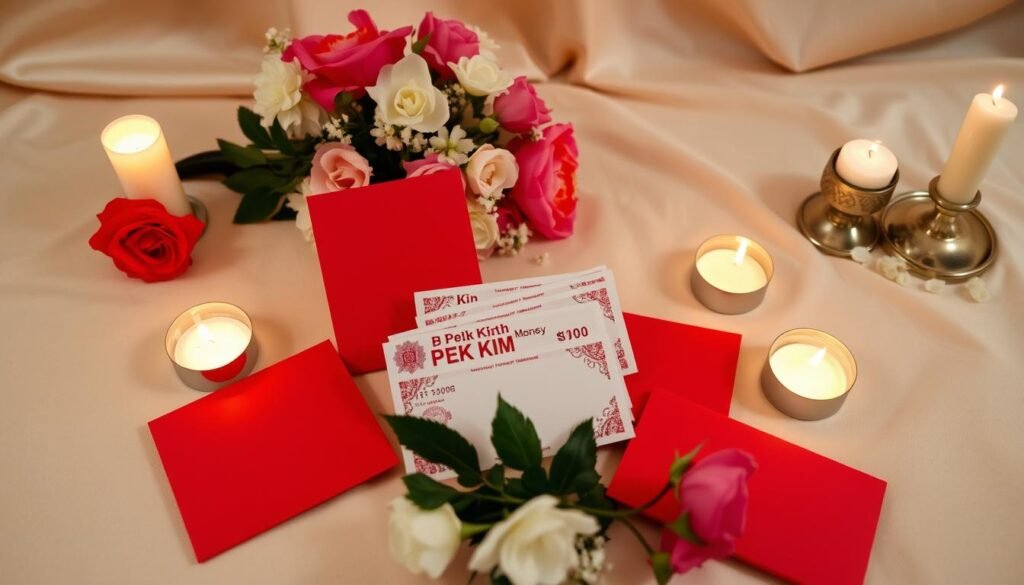
Visitation Etiquettes: Timing and Duration
Knowing when to visit during wake hours is key to showing respect. Visiting during the family’s set times is thoughtful. It also lets you connect deeply during a tough time. Visitors should aim for considerate visitation by thinking about when they come and how long they stay.
Best Practices for Attending a Wake
Here are some tips for visiting a wake:
- Go during the wake visiting hours to show you care.
- Weekdays or early or late weekend hours are best.
- Tell the family you’re there, share your condolences, and remember the deceased.
- Keep visits short, if the place gets too crowded or sad.
Checking Family Availability and Comfort
Privacy is very important. Before you go, ask the family if they’re okay with visitors. This shows you care about their feelings and helps them feel supported.
Here’s a quick guide for visiting:
| Aspect | Recommendation |
|---|---|
| Visitation Timing | Match with family’s wake hours |
| Best Days | Weekdays or early or late weekend hours |
| Duration of Visit | Keep it short if it gets too crowded or emotional |
| Checking In | Ask family if it’s okay to visit first |
| Dress Code | Wear formal, conservative clothes |
Customs to Observe at a Chinese Wake
Going to a Chinese wake is a journey through rich traditions and shared beliefs. Guests will join in important rituals that show respect and remembrance. It’s key to understand the role of joss sticks and bowing rituals to honor the deceased and the grieving family.
Importance of Joss Sticks and Bowing
Joss sticks are central to Chinese wake customs. Lighting them at the altar shows respect for the deceased. People bow three times as a sign of mourning and respect.
These actions connect us to cultural beliefs about death. They create a respectful and solemn atmosphere. By participating, we show our condolences in a meaningful way.
What to Do Upon Arrival
When you arrive at a wake, approach the altar quietly to show respect. Light joss sticks as part of the tradition. Then, you can talk briefly but gently with the bereaved family.
It’s okay to offer condolences, but be sensitive to the family’s feelings. Light conversations and support are the right way to act at such a time.
Behavioral Manners to Uphold at a Wake
Going to a wake is a way to show you care and support the family. It’s important to be kind and respectful. Here are some tips to help you behave well during this time.
Interaction with the Bereaved Family
Being empathetic and sincere is key when talking to the family. Share comforting memories and condolences, but avoid asking about the death. Funeral conversations should be supportive and uplifting. Let the family share their feelings without feeling rushed, showing respect for their grief.
Respect for the Mourning Atmosphere
It’s important to act appropriately at a wake. Quiet and respectful behavior helps everyone feel supported. Here are some guidelines to follow:
- Arrive on time, ideally 15-20 minutes early, to show respect during mourning.
- Wear suitable attire, typically conservative and sombre, like black or dark colors.
- Participate politely in rituals, adhering to the established customs of the wake.
- Minimize distractions, avoiding loud laughter or disruptive activities.
- Continuously offer support, as grief does not end with the funeral.
By following these tips, you can help create a positive atmosphere. This shows the importance of maintaining a respectful environment during tough times.
| Guidelines for Guests | Importance |
|---|---|
| Arrive early | Demonstrates respect for the event and the family |
| Wear appropriate attire | Shows honor to the deceased and the family |
| Engage in light conversation | Helps the family feel supported without pressure |
| Practice patience | Allows natural emotions to unfold peacefully |
| Avoid distractions | Maintains a solemn atmosphere conducive to mourning |
The Role of Refreshments in Wake Etiquette
Refreshments at wakes are key, giving nourishment and helping people connect. They offer drinks and food, making a space for sharing memories and comfort. This is vital during tough times.
Many families choose simple yet tasty options like cookies, chips, and finger sandwiches. These appeal to many and are easy to manage, making everyone feel welcome. Casseroles and soups are great for those who want to add more food. They can be reheated and shared, adding to the gathering.
The repast after the wake is a time for light snacks and meals. Items like cheese and crackers, vegetable platters, and cakes are popular. They offer comfort and honor the deceased’s taste in food.
These gatherings are a chance for people to stay, talk, and remember good times. In Singapore, funerals show how important refreshments are. They remind us that food can unite us, even in sorrow.
Conclusion
Knowing how to act at wake services in Singapore is key. It shows respect and helps families in their time of grief. By following cultural norms, we honor the deceased and offer comfort.
A heartfelt eulogy can make a big difference. It shares the good times and achievements of the person who passed away. This way, we create a lasting memory and help others find peace.
It’s important to be aware of different traditions at wakes. This includes what to wear and the meaning of certain rituals. Being considerate helps keep the mourning atmosphere respectful and meaningful.
Wakes can last from three to five days. It’s vital to be kind and understanding during this time. By following these guidelines, we can support our loved ones and build a caring community.
FAQ
What is the purpose of a wake service?
How should I dress when attending a wake in Singapore?
What’s the appropriate way to express condolences?
What are some common rituals during a wake service?
What is pek kim and how should I give it?
When is the best time to visit a wake?
What should I do upon arriving at a Chinese wake?
How should I interact with the bereaved family at a wake service?
Why are refreshments served at a wake?
Source Links
- https://www.singaporeobituary.com/guide-to-attending-a-funeral-wake-in-singapore/
- https://memorialfuneral.com.sg/blog/dos-and-donts-when-attending-a-wake-in-singapore/
- https://www.ljfs.com.sg/understanding-the-importance-of-funeral-services-a-deep-dive-with-last-journey-funeral-service/
- https://funeralservices.sg/all-about-funeral-wakes-in-singapore/
- https://www.funeralpartners.co.uk/help-advice/after-a-funeral/what-is-a-funeral-wake/
- https://www.partinggoodbyes.com/blog-posts/cultural-significance-of-wakes-in-singapore
- https://embracefuneralservices.com.sg/the-different-cultures-of-funeral-rites-in-singapore/
- https://funeralservices.sg/5-essential-things-to-know-before-attending-a-funeral-wake/
- https://www.trinityfuneralchapel.com/funeral-etiquette-viewing-and-visitation-tips
- https://directfuneral.com.sg/dos-and-donts-as-a-guest-attending-a-funeral/
- https://www.nirvanafugui.com/buddhist-funeral-etiquette/
- https://www.asiaone.com/lifestyle/quick-guide-condolence-money-and-funeral-etiquette-singapore
- https://www.empathy.com/funeral/how-to-dress-for-a-wake-or-viewing-ceremony
- https://tharpfuneralhome.com/what-should-i-wear-to-a-wake/
- https://directfuneral.com.sg/how-to-prepare-and-give-condolence-money/
- https://funeralservices.sg/how-much-condolence-money-bai-jin-to-give-at-a-funeral/
- https://perfectmemorials.com/guides/funeral-visitation-and-wake-etiquette-tips?srsltid=AfmBOorFaq299y7nlSJFtBerQ-_ZHLvLEK1kxeqtpvdc8Boi_hs3ltqf
- https://batchelorbrothers.com/blogs/blog-entries/3/Batchelor-Brothers-News-Events/245/Your-Guide-to-Visitation-Etiquette-Eight-Basic-Rules-Everyone-Should-Know.html
- https://embracefuneralservices.com.sg/chinese-funeral-singapore/
- https://memorialfuneral.com.sg/blog/chinese-funeral-singapore/
- https://www.confidencefuneral.com.sg/blogs/catholic-funeral-etiquette-key-dos-and-donts-for-attendees/
- https://eirenecremations.com/blog/funeral-etiquette?srsltid=AfmBOorEGoCh80p0Mh2LawPI4DXZ5gwussYDJxuaRhWddHe5ul6qGRwg
- https://www.bradleyfuneralhomes.com/food-to-serve-at-funeral-reception/
- https://www.funeralsanctuary.sg/dos-and-donts-for-funeral-wake-etiquette-in-singapore/
- https://www.funeralpartners.co.uk/help-advice/arranging-a-funeral/funeral-wake-food/
- https://memorycherish.com/eulogy-endings/
- https://www.funeralsanctuary.sg/what-happens-at-a-christian-funeral-in-singapore/

